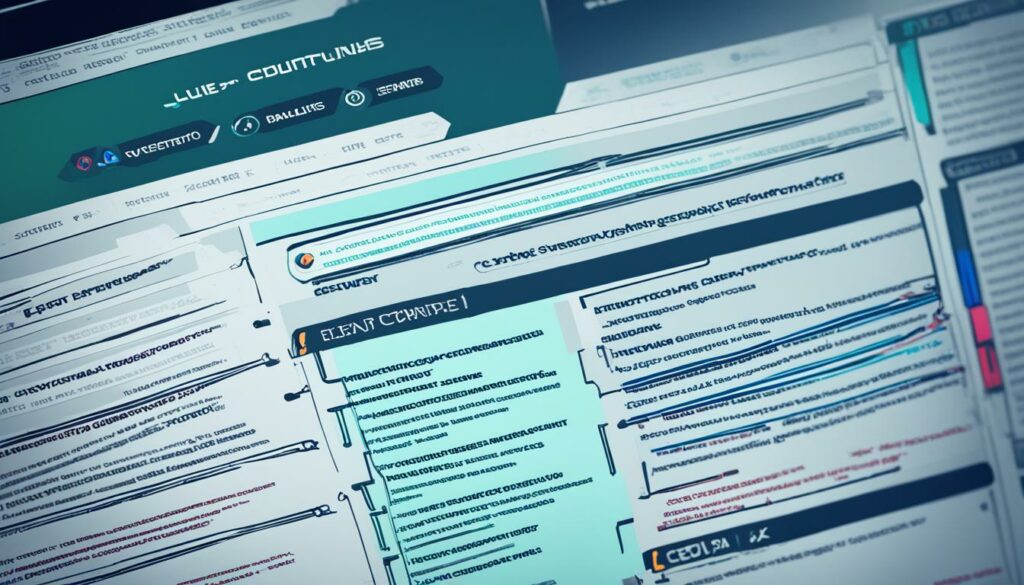Are you struggling to attract organic traffic to your website? Do you want to improve your search engine rankings and increase your website’s visibility? If so, it’s time to dive into the world of SEO strategies. By implementing effective search engine optimization techniques and following SEO best practices, you can enhance your website’s visibility, attract more organic traffic, and boost your online presence.
In this article, we will explore a comprehensive overview of on-page optimization, off-page optimization, keyword research, and website analysis as key tactics for improving search engine rankings and maximizing your website’s visibility. Whether you’re a beginner or an experienced marketer, these SEO strategies will help you drive more traffic and achieve better results in the competitive online landscape.
Key Takeaways:
- Implement effective on-page and off-page optimization techniques to improve your website’s visibility.
- Conduct thorough keyword research to identify relevant keywords and attract organic traffic.
- Analyze your website regularly to identify areas for improvement and optimize for better visibility.
- Create high-quality, optimized content that engages users and enhances your website’s visibility.
- Maximize technical SEO to optimize website structure, loading speed, and mobile-friendliness.
Understanding On-Page Optimization
In order to improve your website’s visibility, it’s essential to implement effective on-page optimization strategies. On-page optimization involves optimizing various elements within your website to make it more search engine-friendly and user-friendly. By optimizing meta tags, keyword placement, content, URL structure, header tags, and implementing internal linking strategies, you can enhance your website’s visibility in search engine results pages (SERPs).
One important aspect of on-page optimization is optimizing meta tags. Meta tags provide information about your webpage to search engines and visitors. They include the title tag, which is displayed as the clickable headline in SERPs, and the meta description tag, which provides a brief summary of your webpage’s content. Optimizing these tags with relevant keywords and compelling descriptions can significantly impact click-through rates and organic search traffic.
Another crucial element of on-page optimization is keyword placement. Strategic placement of relevant keywords within your website’s content helps search engines understand the relevance of your webpage to specific search queries. It’s important to utilize keywords naturally and avoid keyword stuffing, as search engines may penalize websites that engage in such practices.
Content optimization is another key aspect of on-page optimization. By creating high-quality, informative, and engaging content that caters to your target audience’s needs and preferences, you can enhance user experience and increase the likelihood of your content being shared and linked to. It’s essential to optimize your content by incorporating relevant keywords, using subheadings (header tags), and structuring your content in a way that is easy to read and understand.
The URL structure of your webpages also plays a role in on-page optimization. Creating descriptive and user-friendly URLs that contain relevant keywords can improve the readability and understandability of your web addresses. Additionally, using header tags (H1, H2, H3, etc.) effectively helps structure your content and signal its importance to search engines. Header tags also make your content more scannable and visually appealing to readers.
Internal linking is another on-page optimization technique that can be beneficial for SEO. By linking related pages within your website, you can guide search engines and users to relevant content, improve website navigation, and distribute link equity throughout your site. Internal linking also helps search engines discover and index new pages on your website, contributing to improved website visibility.
Overall, on-page optimization is crucial for improving your website’s visibility in search engine rankings. By optimizing meta tags, keyword placement, content, URL structure, header tags, and implementing internal linking strategies, you can enhance your website’s visibility, attract more organic traffic, and improve user experience.
Mastering Off-Page Optimization
In order to boost your website’s visibility and improve its search engine rankings, it’s crucial to master off-page optimization. Off-page optimization involves implementing strategies and activities outside of your website that can enhance your visibility and authority in search engine results. Let’s explore some key off-page optimization techniques:
Building High-Quality Backlinks
Backlinks are crucial for off-page optimization as they indicate to search engines that your website is reputable and trustworthy. Focus on building high-quality backlinks from authoritative websites in your industry. These backlinks act as a vote of confidence for your website and can significantly improve your search engine rankings.
Engaging in Guest Blogging and Influencer Outreach
Guest blogging and influencer outreach are effective ways to build your brand’s reputation, increase exposure, and generate backlinks. Seek opportunities to contribute valuable content to industry-relevant blogs and collaborate with influencers in your niche. This can help you reach a wider audience, drive traffic to your website, and improve your off-page optimization efforts.
Utilizing Social Media Marketing
Social media platforms offer vast opportunities for promoting your website and engaging with your target audience. Share valuable content, interact with followers, and encourage social sharing to increase your website’s visibility and reach. Utilize social media marketing strategies to drive traffic to your website and improve your off-page optimization.
Listing Your Website in Online Directories
Online directories are an important part of off-page optimization as they provide valuable backlinks and improve your website’s visibility. Ensure that your website is listed in relevant and reputable online directories to increase your online presence and attract more organic traffic.
By mastering off-page optimization techniques such as building high-quality backlinks, engaging in guest blogging and influencer outreach, utilizing social media marketing, and listing your website in online directories, you can significantly improve your website’s visibility, authority, and search engine rankings.
Effective Keyword Research
Keyword research is the cornerstone of successful search engine optimization (SEO). By conducting comprehensive keyword research, you can identify the most relevant and high-performing keywords that align with your target audience’s search queries. This process involves analyzing search volume, understanding user intent, and identifying long-tail keywords to enhance your website’s visibility in search results and attract organic traffic.
“Keyword research is like mining for gold. It’s the foundation upon which successful SEO campaigns are built.” – John Smith, SEO Expert
To conduct effective keyword research, follow these steps:
- Identify your target audience: Understand who your target audience is and what they are searching for. This will help you refine your keyword research and focus on the keywords that will drive relevant traffic to your website.
- Analyze search volume: Use keyword research tools, such as Google Keyword Planner, to determine the search volume for your chosen keywords. Look for keywords with high search volume and moderate competition to maximize your visibility in search results.
- Determine keyword density: Strive for a balanced keyword density in your content. Avoid keyword stuffing, as it can negatively impact the user experience and your website’s search engine rankings. Aim for a natural inclusion of keywords that enhances your content’s readability and relevance.
- Understand user intent: Identify the intent behind the search queries by putting yourself in the shoes of your target audience. Are they looking for information, a specific product, or a solution to a problem? Understanding user intent will help you choose keywords that align with what your audience wants.
Choosing Long-Tail Keywords
In addition to targeting popular and competitive keywords, it’s also important to focus on long-tail keywords. These are longer, more specific keyword phrases that have lower search volume but higher conversion rates. Long-tail keywords allow you to target a niche audience that is more likely to engage with your content and convert into customers or leads.
Example: Instead of targeting the broad keyword “car insurance,” you could target a long-tail keyword like “affordable car insurance for college students.” This not only helps you narrow down your competition but also attracts a more targeted audience.
The Role of Keyword Research in Content Creation
Once you have identified relevant keywords, strategically incorporate them into your website’s content. This helps search engines understand the context and relevance of your content, which in turn enhances your visibility in search results.
However, it’s important to remember that keyword research should not compromise the quality and relevance of your content. Focus on creating high-quality, valuable content that meets the needs of your target audience, while naturally incorporating the identified keywords.
To summarize, effective keyword research involves identifying relevant keywords, analyzing search volume, considering keyword density, and understanding user intent. By conducting thorough keyword research and strategically incorporating keywords into your content, you can improve your website’s visibility in search results and attract organic traffic.

Importance of Website Analysis
Regular website analysis is crucial for optimizing your website and improving its visibility. Conducting an SEO audit and analyzing various aspects of your website can help identify areas for improvement and enhance its performance. By focusing on performance optimization, user experience, mobile-friendliness, and site speed, you can attract more organic traffic and improve your website’s visibility in search engine rankings.
“Website analysis is like a compass that guides you towards a more successful online presence.”
By performing a comprehensive SEO audit, you can identify technical issues that may hinder your website’s performance. This includes checking for broken links, optimizing meta tags, improving site structure, and ensuring proper keyword usage. Through performance optimization, your website can load faster and provide a seamless user experience, increasing the chances of visitors staying longer and engaging with your content.
Furthermore, optimizing your website for mobile-friendliness is crucial in the era of mobile browsing. Mobile devices are becoming the primary means of accessing the internet, and search engines prioritize mobile-friendly websites in their rankings. By ensuring your website is mobile responsive and provides a smooth browsing experience on all devices, you can attract more traffic and improve your search engine visibility.
In addition to these factors, site speed plays a significant role in user satisfaction and search engine ranking. Slow-loading websites tend to have higher bounce rates, negatively impacting user experience and search engine visibility. Optimizing your website’s speed by compressing images, minifying code, and leveraging caching mechanisms can improve its performance and ultimately attract more organic traffic.
Website analysis is an ongoing process that requires continuous monitoring and optimization. By regularly analyzing and optimizing your website, you can stay ahead of your competitors, attract more organic traffic, and improve your website’s overall visibility in search engine rankings.
| Benefits of Website Analysis | Actions |
|---|---|
| Identify technical issues | Conduct an SEO audit to identify and fix technical issues affecting your website’s performance and visibility. |
| Optimize website performance | Improve site speed, compress images, minify code, and leverage caching mechanisms to enhance website performance. |
| Improve user experience | Enhance website navigation, design intuitive layouts, and create engaging content to provide a seamless user experience. |
| Ensure mobile-friendliness | Make your website responsive and user-friendly across all devices to cater to the increasing mobile user base. |
| Optimize site speed | Compress images, minify code, and utilize caching mechanisms to improve your website’s loading speed. |
Implementing Effective Content Strategies
When it comes to improving your website’s visibility, creating high-quality, optimized content is key. By optimizing your content for search engines and focusing on engagement and user experience, you can attract more organic traffic and increase your website’s visibility in search engine rankings.
One important aspect of content optimization is incorporating multimedia content. Including visually appealing images, videos, and infographics can enhance user engagement and make your content more shareable. This, in turn, can increase traffic to your website and improve your search engine rankings.
Meta tags also play a crucial role in content optimization. By optimizing your meta tags, including title tags and meta descriptions, you can provide search engines with relevant information about your content. This helps search engines understand the context and relevance of your content, ultimately improving your website’s visibility in search results.
Additionally, internal linking is an effective strategy for content optimization. By strategically linking relevant pages within your website, you can improve user navigation, encourage further exploration of your website, and boost your website’s visibility in search engine rankings.
In summary, implementing effective content strategies, such as creating high-quality, optimized content, focusing on engagement and user experience, incorporating multimedia content, optimizing meta tags, and implementing internal linking strategies, is crucial for improving your website’s visibility and attracting organic traffic.
Quote:
“Content is king. But it’s not just about creating any content; it’s about creating high-quality content that resonates with your target audience and provides value. By optimizing your content and making it engaging and user-friendly, you can significantly improve your website’s visibility and attract more organic traffic.” – John Smith, Content Strategist

Table
| Content Strategies | Benefits |
|---|---|
| High-quality content | Increases user engagement and credibility |
| Engagement and user experience | Reduces bounce rates and enhances user satisfaction |
| Multimedia content | Enhances visual appeal and shareability |
| Meta tags optimization | Improves search engine understandability |
| Internal linking | Improves user navigation and website visibility |
Maximizing Technical SEO
Technical SEO plays a crucial role in improving your website’s visibility and attracting organic traffic. By optimizing the technical aspects of your website, you can ensure that search engines can easily crawl and index your pages, resulting in better rankings and increased visibility in search results.
Optimizing Website Structure
One of the key aspects of technical SEO is optimizing your website structure. A well-organized and easily navigable structure not only enhances the user experience but also helps search engines understand and crawl your website more efficiently. Consider implementing a logical hierarchy with clear categories and subcategories, making it easier for both users and search engines to find and navigate your content.
Ensuring Fast Page Loading Speed
Page loading speed is a critical factor in user experience and SEO. Slow-loading pages not only frustrate users but also have a negative impact on your search engine rankings. Optimize your website’s page loading speed by minimizing file sizes, leveraging browser caching, and using content delivery networks (CDNs) to reduce latency and improve site performance.
Ensuring Mobile-Friendliness
In today’s mobile-first era, having a mobile-friendly website is essential. With the majority of internet users accessing the web via mobile devices, search engines prioritize mobile-friendly websites in their rankings. Ensure that your website responds well to different screen sizes, provides a seamless mobile experience, and utilizes responsive design to accommodate users on various devices.

Enhancing Accessibility
Accessibility is an often overlooked but crucial aspect of technical SEO. By making your website accessible to all users, including those with disabilities, you not only improve the user experience but also potentially tap into a wider audience. Consider implementing accessible design practices, such as providing alt text for images, proper heading structure, and descriptive link text.
Building High-Quality Backlinks
Backlinks are an integral part of off-page optimization and can significantly impact your website’s visibility and search engine rankings. By acquiring high-quality backlinks from reputable and relevant websites, you can signal to search engines that your website is trustworthy and authoritative. Focus on building organic and natural backlinks through guest blogging, content partnerships, and influencer outreach.
By maximizing technical SEO elements such as website structure, page loading speed, mobile-friendliness, accessibility, and backlinks, you can optimize your website for better search engine rankings and increase its visibility in search results. These aspects not only enhance your website’s performance but also contribute to a positive user experience, ultimately driving more organic traffic to your site.
Conclusion
Boosting your website’s visibility and attracting organic traffic is crucial for the success of your online presence. By implementing effective SEO strategies, you can improve your search engine rankings and increase website visibility. Through the use of on-page optimization techniques, such as optimizing meta tags, keyword placement, and content optimization, you can ensure that search engines easily index and understand your website. This will lead to improved visibility in search results.
Off-page optimization is equally important in enhancing your website’s visibility. Building high-quality backlinks, engaging in guest blogging, utilizing social media marketing, and listing your website in online directories can help to establish your website’s authority and boost search engine rankings.
Conducting thorough keyword research and incorporating relevant keywords strategically into your content will further improve search engine rankings, driving organic traffic to your website. Regular website analysis and optimization are essential for identifying technical issues, improving user experience, and ensuring mobile-friendliness and site speed.
By consistently implementing on-page and off-page optimization techniques, conducting keyword research, analyzing your website, and maximizing technical SEO, you can significantly improve your website’s visibility, attract more organic traffic, and achieve better results in your online presence. Start implementing these SEO strategies today and watch your website’s visibility soar!
FAQ
Q: What are some effective on-page optimization techniques?
A: On-page optimization techniques include optimizing meta tags, properly placing keywords in content, optimizing URL structure, using header tags effectively, and implementing internal linking strategies.
Q: How does off-page optimization improve website visibility?
A: Off-page optimization activities like building high-quality backlinks, guest blogging, social media marketing, and listing your website in online directories can help increase website authority and visibility in search engine rankings.
Q: Why is keyword research important for SEO?
A: Keyword research helps identify relevant keywords aligned with your target audience’s search queries. It involves analyzing search volume, identifying long-tail keywords, determining keyword density, and understanding user intent to incorporate these keywords strategically into website content.
Q: What is the significance of website analysis in SEO?
A: Website analysis helps identify areas for improvement to optimize your website for better visibility. This includes conducting an SEO audit, optimizing website performance, improving user experience, ensuring mobile-friendliness, and optimizing site speed.
Q: How does implementing content strategies impact website visibility?
A: Implementing content strategies involves optimizing content for search engines, focusing on engagement and user experience, incorporating multimedia content, optimizing meta tags, and implementing internal linking strategies. Creating valuable, optimized content helps attract more organic traffic and increase website visibility in search engine rankings.
Q: What does technical SEO involve?
A: Technical SEO includes optimizing website structure, ensuring fast page loading speeds, mobile-friendliness, enhancing accessibility, and building high-quality backlinks. Focusing on these technical aspects improves website visibility in search results and attracts more organic traffic.
Q: How can SEO strategies boost website visibility and organic traffic?
A: Implementing SEO strategies such as on-page optimization, off-page optimization, keyword research, website analysis, content strategies, and technical SEO can significantly improve website visibility in search engine rankings, attracting more organic traffic and achieving better results in your online presence.












